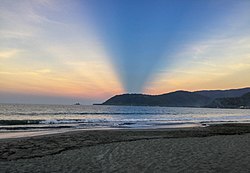Aurora | |
|---|---|
(from top: left to right) Cuaresma beach in Casiguran, Dicasalarin Cove in Baler, Dinadiawan Beach in Dipaculao, Ditawini beach in Dinalungan | |
 Location in the Philippines | |
| Coordinates: 15°53′N 121°33′E / 15.88°N 121.55°E | |
| Country | Philippines |
| Region | Central Luzon |
| Founded | 1951 (as sub-province of Quezon) |
| Province | 13 August 1979 |
| Named for | Aurora Quezon |
| Capital | Baler |
| Largest Municipality | Maria Aurora |
| Government | |
| • Governor | Christian M. Noveras (PFP)[1] |
| • Vice Governor | Jennifer A. Araña (PFP) |
| • Legislature | Aurora Provincial Board |
| Area | |
• Total | 3,147.32 km2 (1,215.19 sq mi) |
| • Rank | 42nd out of 81 |
| Highest elevation | 1,901 m (6,237 ft) |
| Population (2020 census)[3] | |
• Total | 235,750 |
| • Rank | 70th out of 81 |
| • Density | 75/km2 (190/sq mi) |
| • Rank | 77th out of 81 |
| Demonym(s) | Auroran, Auroreño |
| Divisions | |
| • Independent cities | 0 |
| • Component cities | 0 |
| • Municipalities | |
| • Barangays | 151 |
| • Districts | Legislative district of Aurora |
| Demographics | |
| • Ethnic groups |
|
| • Languages | |
| Time zone | UTC+8 (PST) |
| ZIP code | 3200–3207 |
| IDD : area code | +63 (0)42 |
| ISO 3166 code | PH-AUR |
| Website | www |
Aurora, officially the Province of Aurora (Filipino: Lalawigan ng Aurora; Ilocano: Probinsia ti Aurora), is a province in the Philippines located in the eastern part of Central Luzon region, facing the Philippine Sea. Its capital is Baler and borders, clockwise from the south, the provinces of Quezon, Bulacan, Nueva Ecija, Nueva Vizcaya, Quirino, and Isabela. Maria Aurora is the only landlocked town in the province and yet, the most populous. It is the only province in Central Luzon that has no chartered cities.
Before 1979, Aurora was part of the province of Quezon. Aurora was, in fact, named after Aurora Aragon, the wife of Manuel L. Quezon, the president of the Philippine Commonwealth, after whom the mother province was named.
- ^ Malig, Jun (October 11, 2024). "CA orders reinstatement of Aurora governor". Philippine Daily Inquirer. Retrieved October 11, 2024.
- ^ "List of Provinces". PSGC Interactive. Makati, Philippines: National Statistical Coordination Board. Archived from the original on 19 April 2016. Retrieved 5 March 2020.
- ^ Census of Population (2020). "Region III (Central Luzon)". Total Population by Province, City, Municipality and Barangay. Philippine Statistics Authority. Retrieved 8 July 2021.






